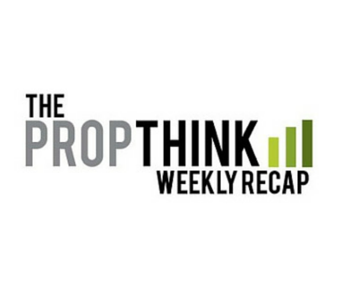The range that had dominated trading in the S&P 500 for all of 2015 (which we wrote about last weekend) finally came to an end this Friday (the 13th, nonetheless). The S&P broke out into uncharted territory late in the week, making new all-time highs at 2097.

This week was busy for much of the PropThink team with the annual BIO CEO & Investor Conference in New York. But, the conference was a great opportunity to catch up on and learn some of the newer healthcare IPO’s from 2013 and 2014, of which there were many. (2014 actually topped 2000 in terms of the number of IPOs).
One that stuck out during the conference was Pfenex (PFNX), which announced on Tuesday morning a licensing deal with Hospira (HSP) in which Hospira will commercialize Pfenex’s lead biosimilar candidate, PF582, globally. PF582 is a biosimilar to Lucentis (ranibizumab), and Hospira will pay Pfenex $51 million upfront for product rights, $291 million in future milestones, and double-digit royalties on future sales. For a $170 million company, the deal is quite meaningful.
In the days since the Hospira agreement, PFNX climbed from $8.00 to $12.45, a 50% gain by the end of the week.
Recall that last week Pfizer (PFE) announced that it is purchasing Hospira for the company’s injectable generics and biosimilars business. Biosimilars, or “similar” versions of approved biologic products, are still a new phenomenon in the U.S. and are quite different from generic small molecule drugs. The E.U. has been more receptive than the FDA to this class of products, though early last month an FDA advisory panel voted unanimously to approve the first biosimilar in the U.S., Novartis’ (NVS) replacement for filgrastim. The regulatory path, and how the FDA treats a biosimilar’s “interchangeability” with the reference product, are still in flux.
Pfenex touts 13 partnerships for its Pfenex Expression Technology platform; however, most of these partnerships are quite old, and the company’s technology has been around for 20 years. The platform originated at Mycogen Corporation and was developed at The Dow Chemical Company. Pfenex was spun out from Dow in 2009 and IPO’d in July of 2014.
The reason investors big PFNX up in the wake of the Hospira deal: besides the $2.50/share in cash, it suggests that Pfenex “still has it.” Hospira is a major biosimilar player and is stepping into the collaboration months or weeks before Pfenex reports data from a phase 1b/2a clinical trial comparing PF582 to Lucentis injections. Clearly, Hospira has confidence.
Fellow small-cap biosimilar developer Epirus (EPRS) is also up 50% in the week since Pfizer announced its purchase of Hospira. Biosimilars will continue to be a hot item in the next few years as many major biologic products in the U.S. and abroad come closer to patent and exclusivity expiry. Now’s the time to get familiar with these developers, though as the patent cliff edges closer and the pipeline begins to crowd, this space will become more difficult to navigate. Coherus (CHRS) is another biosimilar name to know, with an impressive management team.
Famed hedge fund manager Kyle Bass has taken aim at the pharmaceutical industry, attempting to invalidate patents protecting major drug products. In turn, he hopes to profit as an investor.
In a presentation titled “The US Has A Drug Problem” Bass explained this January that his hedge fund, Hayman Capital, would target more than a dozen pharmaceutical companies with a combined market value of $450 billion. Bass planned to use a relatively new patent re-evaluation process called an Inter Partes Review (IPR), which emerged with the America Invents Act in 2012. Under the process, a third party can request that the USPTO review any unexpired patent, without going through the traditional and lengthy court process.
On Tuesday Bass filed his first Inter Partes Review (IPR) petition with the U.S. Patent and Trademark office, challenging claims in one of the key patents protecting Acorda Therapeutics’ (ACOR) product Ampyra from generic drug makers. Bass will most likely continue to go after mid-size drug companies that are dependent on a handful of drugs – or a single product – for the majority of their revenue, like Acorda
Our view? Bass’s approach may be more bark than bite. Mr. King explained on Friday why he’s skeptical of the approach and highlighted some statistics on the two full years since the processes’ creation.Genzyme (of Sanofi [SNY]) announced on Wednesday a collaboration with the private gene therapy company Voyager Therapeutics to develop and commercialize products for severe neurological disorders. Voyager was launched just last year (a Series A round raised $45 million) with a focus on developing adeno-associated virus (AAV) gene therapies for Parkinson’s disease, Friedreich’s ataxia, and Huntington’s among other CNS disorders. Gene therapies and the potential for one-time “cures” to genetic disorders have captured the attention of Wall Street, most recently with the $161 million IPO of Spark Therapeutics (ONCE). We’ve written in more depth about fellow developers bluebird bio (BLUE) and uniQure (QURE) at PropThink, which you can read here, but the Voyager-Genzyme partnership is simply more evidence that gene therapy may finally be coming of age. With a plethora of data this year from proof of concept studies running the gamut of disease indications (Baxter (BAX) presented initial data this week for its own Hemophilia B product), 2015 and 2016 will be exciting years for these novel therapies.
 Try PropThink Premium at 50% OFF for one month
Try PropThink Premium at 50% OFF for one month


